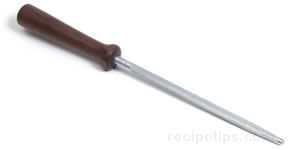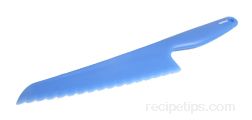Similar Content to: Boning Knife

The simplest of all Sharpeners is the sharpening stone most often made as a rectangular or round-shaped stone with a thickness of 1/2 to several inches. The common varieties include the whetstone or the carborundum stone. A whetstone is made from silicone dioxide minerals that are mined and separated into soft, medium or hard grade stones. To prepare the stone, a light weight lubricating oil is added to the stone in order to stimulate the natural oils within that assist to sharpen a blade as one edge is lightly rotated in a circular motion on the stone. Different grades of stones provide different results for heavier or lighter grade steel blades.
A carborundum stone is an abrasive material made of silicon carbide that sharpens blades and, over time, deteriorates in surface structure as continual sharpening wears down the carbide material. Rectangular in shape, this stone often has a smooth and a coarse side, referred to as a double-grit stone. The coarse side is used first and then the knife is finished by using the smooth side. To sharpen the blade, one side of the blade is drawn straight across the flat surface of the stone. The knife is then turned over to the other side of the blade and the process is repeated. The coarse side enables the blade to be ground into shape fairly quickly while the smooth side adds a smoother finish and a sharper edge, eliminating barely visible rough edges.
Another variety of Knife Sharpener is the Sharpening Steel that consists of a round or elliptical steel shaft with a fine textured grinding surface to sharpen knife edges manually. The knife blade is drawn across the steel in an arcing motion while the steel is held firmly in place.
Manual sharpeners that are considered to be countertop utensils are also available that are more detailed than the Sharpening Steels. Tools that are built with grinding devices built into plastic or metal cases are often small in size but able to simplify the sharpening activities considerably. Often, the Knife Sharpener will contain a diamond coated abrasive or a tungsten carbide grinding stone for sharpening. A knife is drawn light through the grinding stone at an angle that is preset with the use of guides that keep the knife angle fairly consistent as it is drawn across the sharpening stone. Four to six draws of the blade is usually sufficient to keep the blade well honed. A guard is commonly attached to the sharpener so hands are kept safetly away from the knife blades.
Electrical knife sharpeners are another alternative for shapening knifes and are a type of utensil that often simplifies the sharpening process, particularly if the knives are being used frequently for various food cutting activities. Electric sharpeners are designed with basic features for home or moderate use as well as sharpeners built for higher volume usage, such as commercial sharpeners. When selecting consider the size desired, the type of grinding material on the stones, the types of blades that can be sharpened with the device, the safety features, and the ease of cleaning to remove small bits of edge grindings. Lower priced models will contain only one sharpening slot that offer single sharpening features while other models will have sharpening sections for different purposes such as pre-sharpening to remove burrs and old edges before placing the knife in the sharpening or honing section to finish the process. If a knife is to be used only periodically with a minimal amount of cutting, select the lower priced models. However, if the slicing, dicing and cutting chores are frequent, the higher priced or more heavy duty models may be a much better option for keeping all types of knives well sharpened.
Remember when sharpening blades, not all sharpeners work well with all types of knives. Check the capabilities of the sharpener before attempting to sharpen various knives. Also, when sharpening only use a light amount of pressure as the blade presses against the stone. With most knives manufactured in the past few years, only several swipes through a sharpening stone are required and should be sufficient to keep the blade well honed.









